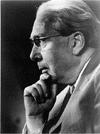Leo Szilard
Leo Szilard Online
Gene Dannen - gene@dannen.com
Welcome to the world of physicist,
biophysicist, and "scientist of
conscience" Leo Szilard (1898-1964). How do
you say it? Say SIL-ahrd.
Szilard's ideas included the linear accelerator,
cyclotron, electron microscope, and nuclear chain
reaction. Equally important was his insistence
that scientists accept moral responsibility for
the consequences of their work.
In his classic 1929 paper on Maxwell's Demon,
Szilard identified the unit or "bit" of
information. The World Wide Web that you now
travel, and the computers that make it possible,
show the importance of his long-unappreciated
idea.
http://www.dannen.com/szilard.html
Leo Szilard Papers: Biography/History
Leo Szilard is best known for his
pioneering work in nuclear physics, his
participation in the Manhattan Project during
World War II, and his opposition to the nuclear
arms race in the postwar era.
It was on a street corner in London, in October
1933, that Szilard first conceived of the
possibility of a nuclear chain reaction. The
possibility of such a chain-reaction -- the
process essential for the releasing of atomic
energy -- had been dismissed by the eminent
physicist Lord Ernest Rutherford. Szilard
successfully proved Rutherford wrong.
On December 2, 1942, Szilard and his colleagues
demonstrated the first nuclear chain reaction.
This demonstration took place in the graphite
block reactor built under the grandstand at the
University of Chicago's Stagg Field. This
successful experiment was in part the result of
Szilard's atomic theories.
Throughout the Manhattan project, Szilard was
often frustrated by cumbersome government
administration and security regulations. Szilard
viewed the production of the atomic bomb as a
necessary counter-measure to the possibility of
German nuclear development anddeployment, but he
foresaw the global consequences of the
proliferation of this weapon. After Germany
surrendered, Szilard organized his colleagues to
press for limitations in the use of the atomic
bomb. In July 1945 Szilard circulated a petition
urging President Truman not to drop the atomic
bomb on Hiroshima.
After the war Szilard began to focus on biology,
a field he had long been interested in. After
1958, with the increasing threat of nuclear war,
Szilard's political activities intensified.
http://orpheus.ucsd.edu/speccoll/testing/html/mss0032d.html
Leo Szilard
Leo Szilard, along with Enrico
Fermi, was awarded a patent for the nuclear
fission reactor in 1955. Throughout his lifetime,
Szilard made significant contributions to the
fields of statistical mechanics, nuclear physics,
nuclear engineering, genetics, molecular biology,
and political science. Szilard fully understood
the implications of nuclear fission, and it was
he who coordinated the letter sent to President
Roosevelt from Einstein encouraging the
establishment of the Manhattan Project.
http://www.invent.org/book/book-text/116.html
 Leo Szilard Leo Szilard
Leo Szilard (1898-1964), a
native of Budapest and naturalized US citizen
elected to Academy membership in 1961, was noted
for his contributions to the fields of
thermodynamics, biophysics, nuclear physics, and
the development of atomic energy. Szilard,
experimenting in collaboration with Fermi, Zinn,
and Anderson, proved the possibility of a nuclear
chain reaction, but he may be best known for his
role in the initiation of the Manhattan Project
for developing an atomic bomb during World War
II.
http://www.nas.edu/history/members/szilard.html
Leo Szilard (1898-1964) & Creative
Quotations
"We turned the switch, saw
the flashes, watched for ten minutes, then
switched everything off and went home. That night
I knew the world was headed for sorrow."
Leo Szilard (1898-1964) born on Feb
11. Hungarian-USA scientist.
He, with Enrico Fermi, conducted the first
nuclear chain reaction, 1942; was instrumental in
initiating the Manhattan Project to build the
atom bomb.
http://www.bemorecreative.com/one/1350.htm
The Birth of the Bomb: Leo Szilard by
Donald Williams, Jungian analyst
Donald Williams
In 1933, Leo Szilard was standing on
a London streetcorner waiting for the light to
change from red to green when he grasped the
possibility of splitting the atom and creating a
chain reaction. In 1934, he filed his patent and
tried to leave the idea in secrecy with the
British War Office, but they didn't take him
seriously. In 1938, in the midst of Hitler's
growing storm, Otto Hahn, a chemist, bombarded
uranium with neutrons at the Kaiser Wilhelm
Institute in Berlin; to his astonishment he split
the atom. The news reached Neils Bohr in 1939 and
spread with him when he fled Denmark to the
United States to escape the Nazis. Szilard moved
to New York in 1939, heard the news, and feared
that the Germans would develop the atomic bomb
and use it. There was reason for fear: the
Germans had already banned the export of uranium
from the Joachimsthal mines of now occupied
Czechoslovakia. Szilard was soon collaborating
with Eugene Wigner, Albert Einstein, Neils Bohr,
Edward Teller and other physicists on the
possibility of an atomic weapon. Later in 1939,
these men sent an emissary to present their case
to Roosevelt, and he got the point: "...what
you are after is to see that the Nazis don't blow
us up."
http://www.cgjung.com/articles/szilard.html
Szilárd Library - General Information
The main responsibility of the
Szilárd Library is to offer the scientific
literature covering the research areas of EMBL as
comprehensively as possible.
The Szilárd Library offers various methods for
researching and acquiring scientific information.
http://library.embl-heidelberg.de/allg.html
Leo Szilard: A Symposium in Celebration
of the 100th Anniversary of his Birth.
Szilard as an Inventor: accelerators
and more V.L.
Telegdi (UCSD La Jolla and CERN)
Leo Szilard: Physics, Politics, and the Narrow
Margin of Hope. William Lanouette
Beller Lecture: The Roots of Leo Szilard and his
Interdisciplinarity George Marx (Eötvös University,
Budapest, Hungary)
Leo Szilard. Toward A Livable World. Edward Gerjuoy
(University of Pittsburgh, Pittsburgh, PA 15260)
http://www.aps.org/BAPSAPR98/abs/S395.html
|



